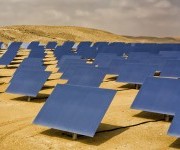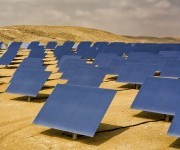 Since the new center-right coalition won the elections a few weeks ago in Germany, onlookers from the U.S. have been expecting the country to drastically cut its support for solar. Proponents of U.S.-style policies, such as tax credits and Renewable Portfolio Standards, have also been hinting that Germany will be yet another example of how the solely production-based “feed-in rates” can overheat a system. (Germany will install close to two gigawatts of solar this year. When Spain installed 2.5 gigawatts last year, the Spanish considered the market overheated and imposed a ceiling of 500 megawatts per year.)
Since the new center-right coalition won the elections a few weeks ago in Germany, onlookers from the U.S. have been expecting the country to drastically cut its support for solar. Proponents of U.S.-style policies, such as tax credits and Renewable Portfolio Standards, have also been hinting that Germany will be yet another example of how the solely production-based “feed-in rates” can overheat a system. (Germany will install close to two gigawatts of solar this year. When Spain installed 2.5 gigawatts last year, the Spanish considered the market overheated and imposed a ceiling of 500 megawatts per year.)
But finally, word is trickling out in English that the new governing coalition does not in fact plan to slash solar. An unnamed source told Reuters that rates might be cut by “around 15 percent,” but not 30 percent in line with the fall in module prices. (The rates would already automatically drop by between 9 and 12 percent, so 15 percent is not much of a jump.)
This news comes as no surprise to those of us who have been following events in German. You might expect Germany’s Energy Consumer Association, a watchdog organization that regularly takes utilities to court for raising prices (and often wins), to oppose FITs because they also raise electricity rates. It doesn’t. In fact, the organization even explains why the rates for solar should not chase after module prices in the following press release (my translation):
October 8, 2009. The Association of German Energy Consumers opposes a drastic cut in compensation for PV arrays. A dramatic reduction in the feed-in rate would be fatal for the PV sector and destroy the momentum of previous years overnight.
The billions paid by consumers to set up the PV sector would have lead nowhere, and the future of the industry would be uncertain.
Over the past few months, prices for PV arrays have fallen faster than manufacturers have been able to reduce production costs. These firms are therefore in financial trouble, and there have already been a number of bankruptcies. In China, two-thirds of PV firms disappeared altogether. Politicians need to deal with this situation responsibly.
The Association of German Energy Consumers calls for the feed-in system to be maintained as it has proven to be successful.
Can you imagine any such watchdog group in the U.S. supporting the most expensive form of renewable electricity? Welcome to Germany.
The reason why Germany has been so successful with renewables is because there is such widespread consent. For instance, if you are expecting the newly elected Christian Democrats to oppose solar, then you obviously missed this statement made in an interview by the CDU politician “tipped to become federal environment minister“:
Any sudden change would be wrong. It is true that solar arrays have become much cheaper because the market collapsed. So we do have some leeway to reduce rates. But we have to be prudent about it — it has to be based on a market analysis. We cannot chase after the market by ramping rates up and down every six months. The solar market still needs proper incentives for people to want to install the systems.
Of course, there are two parties to the coalition, so you certainly would expect the libertarian FDP to oppose not only generous support for solar, but all kinds of government intervention. You would be wrong. A member of an E.U. organization sent me a PDF of the FDP’s documents it is using in negotiations with the CDU for the new coalition. From page two of the FDP’s political platform on environmental, agricultural, and consumer protection issues:
“We will continue to promote the expansion of renewables in accordance with current targets, retain the Renewable Energy Act and the unlimited feed-in priority, and make these subsidies more efficient.”
The “unlimited feed-in priority” means that renewable energy has to be accepted on the grid; if necessary, coal, nuclear, and natural gas plants simply have to be ramped down. (The part about making feed-in rates “more efficient” is a bunch of blah blah blah.) Most importantly, this paper clearly states that the FDP will retain the Renewable Energy Act.
I could not find the word “solar” or “photovoltaics” in the document at all. Otherwise, the FDP only emphasizes that Germany has made too many mistakes in the field of biomass/biofuels, so support will be increased (again, via feed-in rates), and too little has been done in the heat sector. If you were expecting an attack on solar, the document is disappointing.
Now imagine one of our two parties in the U.S. ousting the other party in the elections but nonetheless maintaining the previous party’s successful policy for renewables. I can imagine them doing so only to protect U.S. jobs — and indeed, North American renewables policies are increasingly protectionist, with support given only to systems made locally. You now might expect Germany to follow suit, but the German Solar Association (DGS) has come out against the idea that some protectionist measures should be introduced in the country’s Renewable Energy Act to protect German companies from unfair competition from abroad, especially Asia. As the DGS put it, “German manufacturers have to compete with quality, longer warranties, and better service.”
Now imagine solar proponents and environmental organizations in the U.S. saying that U.S. solar companies are simply going to have to learn to compete.
So there you have it — the German solar market is apparently not going to collapse like Spain’s did. There simply is no real opposition to renewables over here any longer. Don’t believe me? Then check out this weather report from a few days ago, in which the weatherman starts off by showing a map of Germany and some superimposed wind turbines. He then explains that the overall output was going to increase drastically over the next 24 hours, producing some 11 gigawatts at times.
How much is that? “As much as 11 nuclear power plants,” the weatherman said. (Germany only has 17 left, and one of them doesn’t work.)
Now imagine a U.S. weatherman subtly fighting for wind and against nuclear — and no one bats an eye.
Welcome to Germany.



